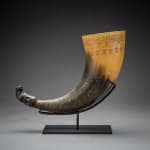Mughal Gunpowder Rhyton, c. 1600 to 1800 CE
Horn
21 x 15 cm
8 1/4 x 5 7/8 in
8 1/4 x 5 7/8 in
PF.7024
Further images
Horn vessel of graduated colour, tapers at one end and sculpted in the shape of a kneeling ram wearing collar; tooled decoration to shaft consisting of tooled concentric circles to...
Horn vessel of graduated colour, tapers at one end and sculpted in the shape of a kneeling ram wearing collar; tooled decoration to shaft consisting of tooled concentric circles to the base and head of the shaft; two incisions. Rhytons were ancient vessels used for drinking wine. Wine would have been poured in at one end and would have flowed out, in this case, from the sides of the ram, which are drilled for this purpose. The name comes from the Greek rhyta, meaning to run through.
Rhytons date back to the Bronze Age and were used by both Minoans and Mycenaean’s. In ancient Cyprus in particular there is a long and prevalent tradition for these vessels throughout the Bronze Age and through commerce and close contact with the Aegean and Mycenaean settlement in late 13th century BCE the praxis spread to mainland Greece. Intermittent periods of Persian rule from 8th century onwards likely lent to the appropriation of the vessel by the Persians. While the concept may be Hellenic, the horn terminating in an animal is believed to have originated in Persia and later spread to other peoples by trade and military campaigns.
Persian kings and commanders often took rhytons with them on military campaigns. Treasures had to be small and portable so they could be carried to wherever warring factions were fighting. The Greek historian Herodotus described the aftermath of the Battle of Platea between Greeks and Persians in 479 BCE. During a raid on the Persian camp, the victorious Greeks found many rythons in gold and silver, which served as inspiration for later Greek rhytons.
There are several extant examples from Central Asia dating to 5th century BCE, which similarly terminate in the forepart of an animal, mostly horses. One example in particular, with a lynx terminal, is also decorated with grapevine leaves. The arrangement of the concentric circles at the top of the vessel as pendant clusters of three may well be interpreted as a stylized grapevine derived from Hellenic sources after the conquests of Alexander the Great during 4th century BCE. The tooled concentric circle is a popular and widely intimated motif in Persian art and can be seen across a plethora of mediums.
The choice of animal was dictated by the beliefs of the culture that produced the vessel. The passage of wine through the ram may have been a sacred rite – a consecration of the liquid within.
A warriors prized possession, this fascinating object elucidates the cross-pollination of cultures between ancient peoples, a love of wine and the most treasured objects of the ancient peoples.
Rhytons date back to the Bronze Age and were used by both Minoans and Mycenaean’s. In ancient Cyprus in particular there is a long and prevalent tradition for these vessels throughout the Bronze Age and through commerce and close contact with the Aegean and Mycenaean settlement in late 13th century BCE the praxis spread to mainland Greece. Intermittent periods of Persian rule from 8th century onwards likely lent to the appropriation of the vessel by the Persians. While the concept may be Hellenic, the horn terminating in an animal is believed to have originated in Persia and later spread to other peoples by trade and military campaigns.
Persian kings and commanders often took rhytons with them on military campaigns. Treasures had to be small and portable so they could be carried to wherever warring factions were fighting. The Greek historian Herodotus described the aftermath of the Battle of Platea between Greeks and Persians in 479 BCE. During a raid on the Persian camp, the victorious Greeks found many rythons in gold and silver, which served as inspiration for later Greek rhytons.
There are several extant examples from Central Asia dating to 5th century BCE, which similarly terminate in the forepart of an animal, mostly horses. One example in particular, with a lynx terminal, is also decorated with grapevine leaves. The arrangement of the concentric circles at the top of the vessel as pendant clusters of three may well be interpreted as a stylized grapevine derived from Hellenic sources after the conquests of Alexander the Great during 4th century BCE. The tooled concentric circle is a popular and widely intimated motif in Persian art and can be seen across a plethora of mediums.
The choice of animal was dictated by the beliefs of the culture that produced the vessel. The passage of wine through the ram may have been a sacred rite – a consecration of the liquid within.
A warriors prized possession, this fascinating object elucidates the cross-pollination of cultures between ancient peoples, a love of wine and the most treasured objects of the ancient peoples.







